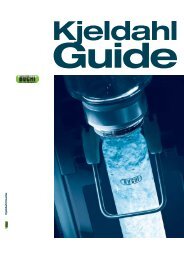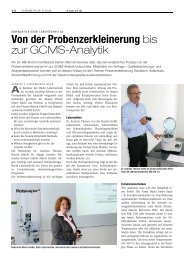The Laboratory Assistant - Buchi
The Laboratory Assistant - Buchi
The Laboratory Assistant - Buchi
You also want an ePaper? Increase the reach of your titles
YUMPU automatically turns print PDFs into web optimized ePapers that Google loves.
Part A Introduction 15<br />
ing essences, distillation was also used by mariners for desalinating sea water.<br />
Alchemists also practiced distillation. <strong>The</strong> teachings of alchemy, which arose in<br />
Egypt during the 2 nd centrury, represented a combination of religious aspects<br />
and chemistry. This was the first «science» that concerned itself in a practical<br />
way with material. Aristotelian natural philosophy had postulated the existence<br />
of a fundamental material with no qualities, the «prima materia». <strong>The</strong> alchemists<br />
sought to transform natural materials chemically into this basic material, and<br />
thento impart to it the new qualities desired, e.g., those of gold (transmutation). In<br />
their search they discovered a large number of chemical compounds, improved<br />
existing processes and equipment, and discovered new processes that have<br />
later been adopted and used in modern chemistry. <strong>The</strong>y also developed distillation<br />
apparatus that, from a design-related stand-point, is still being used today.<br />
Four classical components of the design include: the heating bath, the bubble<br />
flask, the head, and the condenser.<br />
During the 17 th and 18 th centuries, the focus was on the improvement of existing<br />
equipment. <strong>The</strong> equipment was insulated, the process of continuous distillation<br />
was introduced, and water was used as a coolant. <strong>The</strong> vapor distillation<br />
process was also discovered during this time. In selecting the materials for their<br />
apparatus, scientists departed more and more from metal and concentrated on<br />
glass.<br />
At the end of the 17 th century, the Irish physicist Robert Boyle (1627–1691)<br />
who had involved himself intensively with vacuums, performed the first vacuum<br />
distillations. Finally, during the 19 th century, there came the first rectifying col-<br />
umns that made multi-stage distillation possible. A innovative explosion occurred<br />
in the mid-19 th century with the arrival of organic chemistry. New equipment<br />
Figure 1:<br />
Historical distillation equipment<br />
(2 nd century).<br />
Figure 2:<br />
An air-cooled and a<br />
water-cooled distillation<br />
device for laboratory use<br />
(16 th century).





